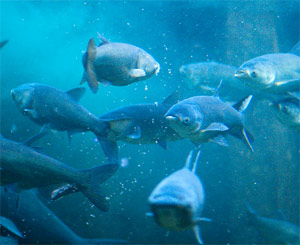Reader Asks: Did Flooding Open Lake Michigan to Asian Carp?
By JoshMogerman in Miscellaneous on Jul 25, 2010 7:00PM
Sometimes you, the readers, have burning questions. Send them. For example, an email from Phillip came into the Chicagoist public inquiry machine yesterday asking “if anyone thinks the Asian Carp were given free admission last night into Lake Michigan when the locks at the Wilmette Pumping station were opened to consider storm drainage.” Great question!
Listening to hours of heavy rain pounding our roofs into the wee hours of Saturday morning, we wondered how our regional water regulators, the Metropolitan Water Reclamation District, would deal with the deluge. The swim bans yesterday and today are the result of locks and sluice gates being opened to relieve the pressure of what the District estimates as 60 billion gallons of rainwater on the system, sending sewage and runoff into Lake Michigan---and potentially unlocking the scenario Phillip fears.
In January, the Army Corps of Engineers announced that eDNA tests from previous months had shown silver carp could be present near MWRD’s Wilmette Pumping Station. The facility’s sluice gates, which were opened around 2:15 a.m. on Saturday morning, are a direct connection with Lake Michigan. The Chicago Lock, next to Navy Pier, was also opened yesterday morning and eDNA tests earlier in the year had pointed to a potential Asian carp presence nearby.
The Asian Carp Regional Coordinating Committee was unable to find fish in either location after the positive tests came back, though there has been some question as to whether the conventional fishing techniques being used were likely to work. Either way, fish swim. There is no way to tell if carp were near either location Friday night or Saturday morning. So it is unclear if the flooding added to the carp-tastrophy. And even if the invasive fish was flushed into the Lake, biologists would point out that a few fish do not constitute the large breeding population necessary to bring on the nightmare scenarios we have all read about this year.
It is clear, however, that this situation will likely become more common as time moves on. From NOAA to the Chicago Climate Action Plan, researchers have repeatedly predicted that climate change will increase the frequency of violent rainstorms around here. And in their SCOTUS filings, MWRD admitted that they have been forced to open the locks to let sewage and runoff flow into the Lake increasingly over the last 10 years. This is part of the reason that the concept of hydrological separation has gained quick acceptance in some circles, as it could deal with both Chicago’s vexing invasive species and wastewater issues at once.
Feel free to drop us a line to tips at chicagoist dot com if you have other issues you want us to tackle. Many thanks for the question Phillip.
